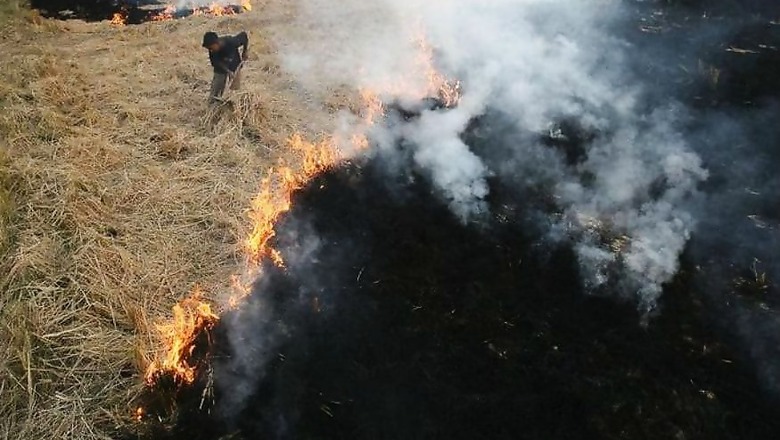
views
New Delhi: The thick layer of smog that engulfs northern India twice a year due to crop residue burning – and is already making its presence felt long before the onset of winter – floats across borders. Both India and Pakistan cause intracountry and transboundary air pollution. But, India suffers more than its neighbour due to the atmospheric trajectory of pollutants towards the southeast from the source regions, a study has found.
The RAND Corporation, a noted global policy think tank based in the United States, in its study ‘Transboundary Environmental Stressors on India-Pakistan Relations’ noted that although such fire activity is observed in both nations in spring, post-monsoon stubble (agricultural waste) burning mostly occurs in India’s Punjab.
“Atmospheric transport patterns show that pollution from post-monsoon agricultural fires flows primarily to the southeast, where it can impact air pollution in other regions in India but generally does not cross the border to Pakistan,” the report said.
However, this changes during the spring season. The atmospheric pathways originating from Pakistan’s Punjab state affect both India and Pakistan. But, “only 20 per cent of pathways that originate from the Indian Punjab state cross into Pakistan; nearly 80 per cent stays within India”.
What this essentially means is that the southeast-ward atmospheric trajectory of pollutants causes most of the smog produced in India to move towards the eastern and southeastern states. A cause of worry here is also the fact that this atmospheric flight of pollutants harms India even more if crop burning increases in Pakistan.
According to a 2015 study published in science journal Nature, each year, air pollution causes more than 645,000 and 111,000 premature deaths in India and Pakistan respectively, with many others facing ailments like difficulty in breathing, upper respiratory illness, choking, etc.
Given this “common enemy”, the smog engulfing Lahore and Delhi has over the years become a point of contention in ties between the two countries. This has the potential to shape into a much required treaty or convention on transboundary pollution in the Indo-Gangetic plain like the UN Convention on Long-range Transboundary Air Pollution in Europe and North America.
The analysis of transboundary air pollution in the RAND study was carried out using satellite observations of fire activity between January 2010 and December 2014 in the primary agricultural regions in India and Pakistan and then mapping atmospheric transport pathways from these source regions. The area under focus in the study was the Punjab state in India and the equivalent areas of Faisalabad, Gujranwala and Lahore districts in Punjab province of Pakistan.
The study used data from the Fire Radiative Power (FRP) observations from the Moderate Resolution Imaging Spectroradiometer (MODIS) sensor onboard the Aqua and Terra satellites to analyse active fires. MODIS measured “daily fire activity at 1-km2 spatial resolution during a morning (10:30am) and afternoon (1:30pm) overpass”. The total energy released from a fire is then quantified into megawatt (MW) for analysis.
“From January 2010 to December 2014, total FRP was 3.9x106 MW across India’s Punjab State. Cumulative FRP observations in Pakistan’s Punjab region were an order of magnitude lower at 7.4x105 MW,” the study found.
For mapping the atmospheric trajectory of pollutants, researchers of the study used the National Oceanic and Atmospheric Administration’s (NOAA) Hybrid Single-Particle Lagrangian Integrated Trajectory (HYSPLIT) model. This model is used across the world for air pollution research.
On Monday, a thick layer of haze was witnessed across Delhi and parts of northern India. The capital recorded a further deteriorating air quality index, hitting the 239 mark in several areas. Chief minister Arvind Kejriwal had taken note of worsening air quality on Saturday when he said that smoke from crop residue burning in neighbouring states had reached the city.
Though Haryana reported a slight decrease in the number of stubble burning incidents, Punjab has reported a massive increase of 45 per cent in such cases till October 11, according to data of pollution control boards of the two states.
Despite a ban on stubble burning in Punjab and Haryana, farmers continue to defy it amid a lack of financial incentives and cropping patterns. Indeed, the RAND study noted India’s cropping pattern as a major cause of worry for worsening air pollution by increased fire activity.
“In Pakistan’s Punjab region, we found the burning predominantly occurred during the April to May peak (the secondary peak for India’s Punjab State). April to May fire activity was more comparable between India and Pakistan’s Punjab regions. This difference is likely caused by multiple factors, such as the type of crop and method of harvesting, although other factors could also play a role,” it said.
The Punjab province in Pakistan mainly grows cotton, wheat and rice, while India’s Punjab state predominantly grows wheat and rice.




















Comments
0 comment